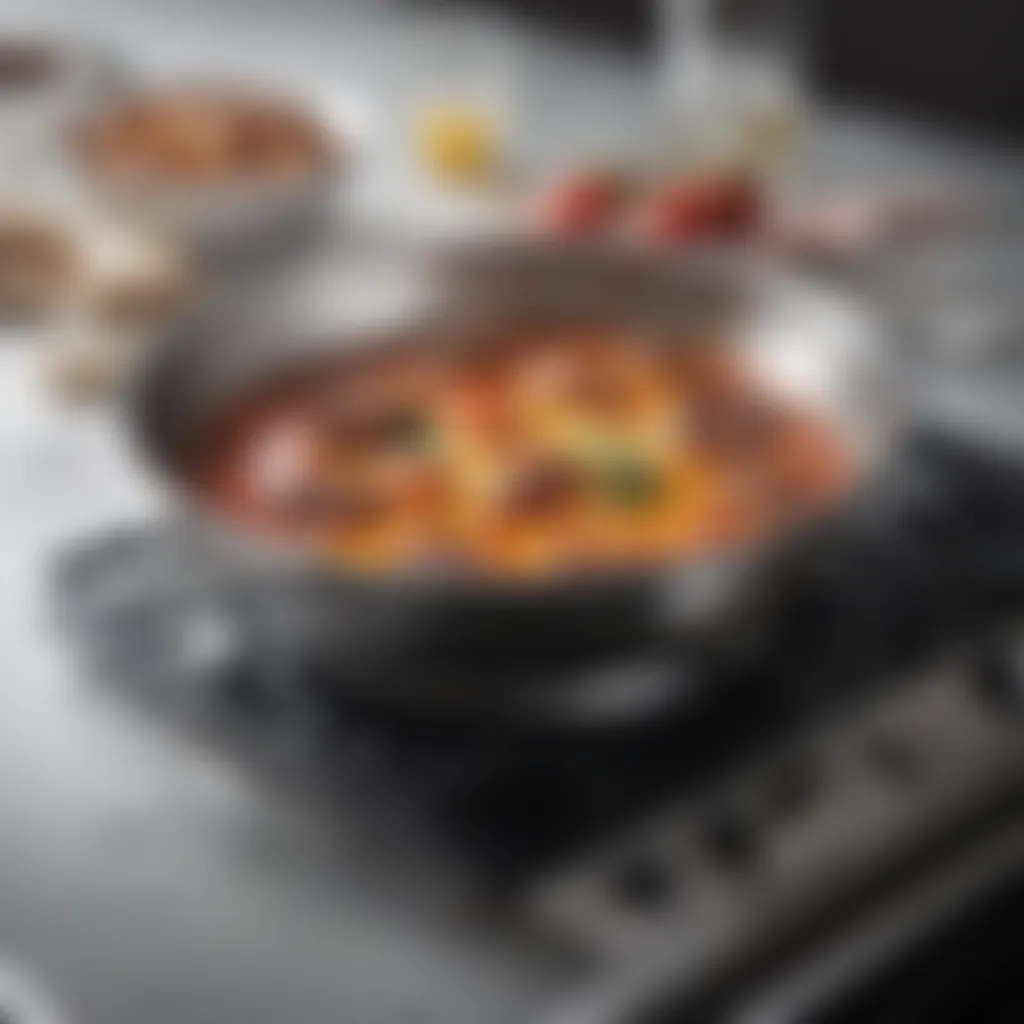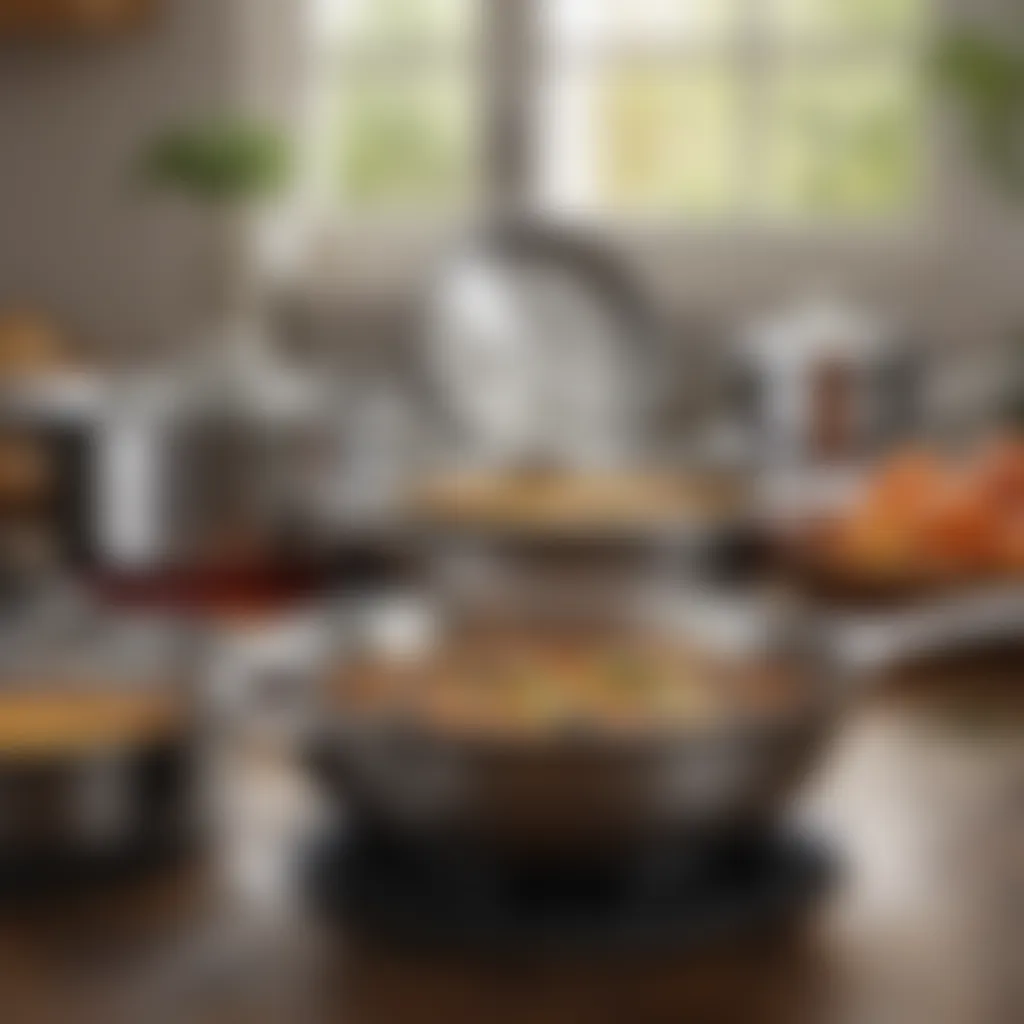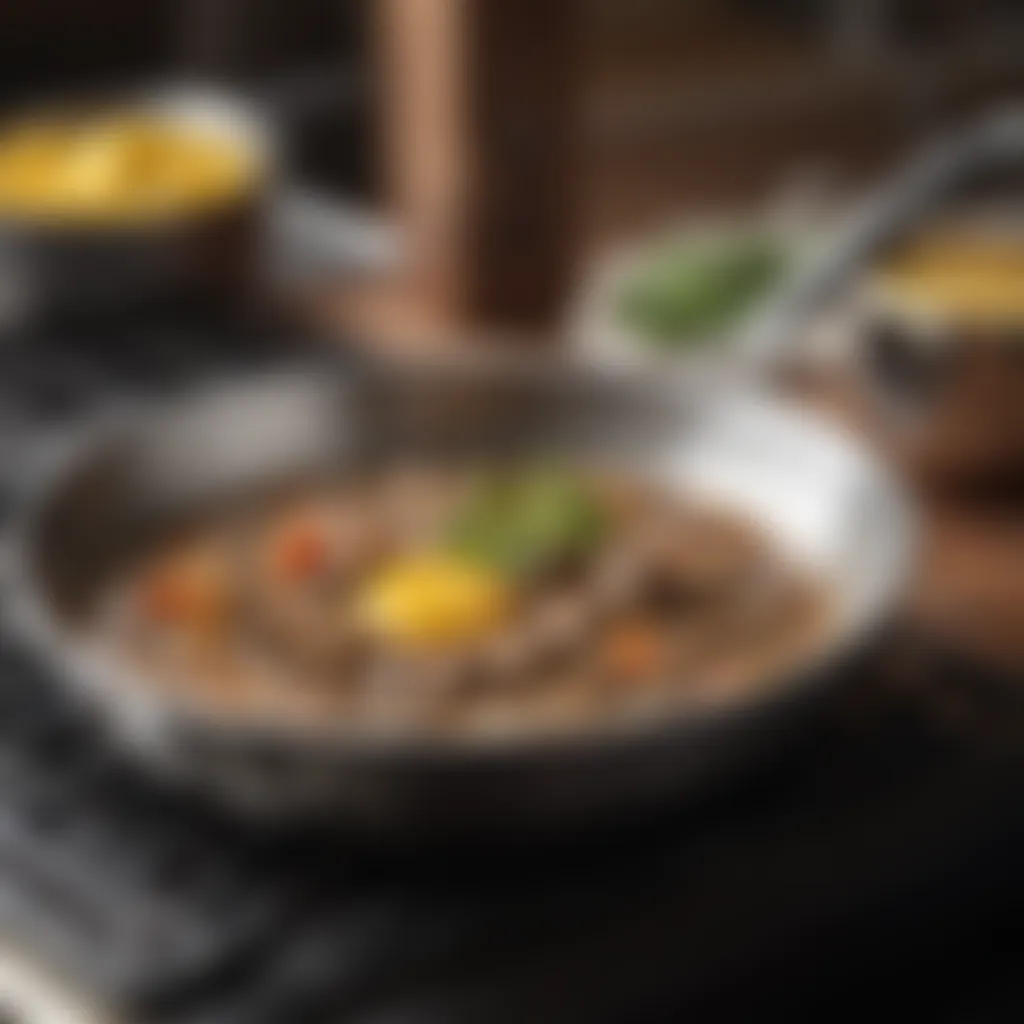The Ultimate Guide to 12-Inch Stainless Steel Skillets


Intro
Stainless steel skillets are versatile tools in any kitchen, especially the 12-inch variety. Their construction combines durability and aesthetic appeal, making them favored by many cooks. Whether for sautéing vegetables or searing meat, the right skillet can enhance the cooking experience. This guide aims to comprehensively explore the essential attributes of these skillets, their benefits, and the considerations one must take into account. As we dive into the specifics of care, usage, and comparisons with other cookware, home cooks can make informed decisions that benefit their culinary adventures.
Ingredients:
To make the most of a 12-inch stainless steel skillet, understanding the key ingredients is fundamental. Below is a detailed list of the ingredients often used in skillet recipes:
- 1 pound of chicken breast, cut into strips
- 2 tablespoons of olive oil
- 1 teaspoon of garlic powder
- 1 teaspoon of paprika
- Salt to taste
- Freshly ground black pepper to taste
- 2 cups of mixed vegetables (bell peppers, zucchini, and onions)
- 1 cup of chicken stock
- 1 tablespoon of fresh basil, chopped
- Lemon wedges for serving
Preparation Steps:
Detailed Instructions:
- Begin by gathering all the ingredients listed above. Ensure the chicken is thawed and cut into strips for easy cooking.
- In a small bowl, mix together garlic powder, paprika, salt, and ground black pepper. This will seasoning will enhance the chicken's flavor.
- Prepare your mixed vegetables by washing and cutting them into bite-sized pieces.
- Heat the stainless steel skillet over medium heat. Add the olive oil once the skillet is hot but not smoking.
- Coat the chicken strips with the seasoning mixture evenly. This ensures each bite is flavorful.
Technical Aspects:
Temperature Settings:
- Heat the skillet to medium heat, approximately 350°F (175°C), before adding any oil or ingredients.
Timing Specifics:
- Cooking chicken strips takes around 5-7 minutes until golden brown.
- Add vegetables and continue cooking for an additional 4-5 minutes.
Critical Techniques:
- Use a spatula to flip the chicken strips gently. Avoid constantly moving them to allow a good sear.
- Monitor the skillet temperature. If smoke starts to appear, reduce the heat slightly.
Cooking Process:
Sequential Steps:
- After heating the skillet, add the seasoned chicken into the skillet in a single layer. Let it cook for about 5-7 minutes, or until it turns golden brown.
- Flip the chicken strips to the other side and cook for another 5 minutes.
- Once chicken is browned, add the mixed vegetables to the skillet. Stir occasionally, ensuring even cooking for around 4-5 minutes.
- Pour in the chicken stock to add moisture and flavor. Let it all simmer for about 3 minutes. This will meld the flavors together.
- Finally, sprinkle fresh basil over the dish before removing it from the skillet. Serve hot with lemon wedges on the side.
Troubleshooting Tips:
- If the chicken sticks to the skillet, it may not have been heated properly before adding oil. Ensure the skillet is sufficiently heated.
- If vegetables seem soggy, reduce the cooking time or heat slightly to encourage browning.
- Overcrowding the skillet can lead to steaming rather than sautéing. Cook in batches if necessary.
"Understanding your cookware and how to use it effectively is essential for mastering any cooking technique."
This guide will continue by addressing the long-term care of stainless steel skillets, their advantages and disadvantages, and comparing them to other types of cookware.
Prelims to Stainless Steel Skillets
Stainless steel skillets hold a significant place in cookware today, often favored by both experienced chefs and home cooks alike. This section aims to shed light on the reasoning behind their popularity. Understanding the relevance of stainless steel skillets provides a deeper comprehension of their features, uses, and maintenance requirements, which are critical for effective cooking.
Definition and Purpose
A stainless steel skillet, generally defined, is a flat cooking pan made primarily from stainless steel alloy. The sleek surface and sturdy build make it ideal for a variety of cooking methods, including frying, sautéing, and searing. One of the main purposes of these skillets is their ability to withstand high temperatures without warping or damaging, providing versatility in the kitchen.
Stainless steel skillets are often preferred for several reasons, including:
- Non-reactive surface: Unlike certain materials, stainless steel does not react with acidic foods, ensuring that flavors remain intact, which is essential when cooking delicate dishes.
- Durability: This cookware is built to last. Resistance to rust and corrosion means that with proper care, these skillets can have a long lifespan.
- Heat conduction: Many stainless steel skillets have an aluminum or copper core, enhancing their heat distribution and allowing for precision cooking.
Historical Context


The use and development of stainless steel itself date back to the early 20th century. Initially popularized in the cutlery industry for its sharpness and resistance to rust, it soon found its way into the cookware sector. The first stainless steel cookware was manufactured in the 1920s. Over decades, advancements in metallurgy led to the refinement of stainless steel alloys specifically designed for cooking. As kitchen needs evolved, so too did the designs and functionalities of skillets made from this durable metal.
In the latter half of the 20th century, the rise of gourmet cooking brought stainless steel skillets into the spotlight. They became a standard in both professional and home kitchens, appreciated for their aesthetic appeal and performance. With the health-conscious movement of the 21st century, these skillets gained renewed attention as an ideal choice for cooking without health concerns associated with non-stick coatings.
The evolution of stainless steel skillets reflects broader trends in culinary practice and consumer preferences, establishing them as indispensable tools in modern cooking.
Material Composition
Understanding the material composition of stainless steel skillets is crucial for anyone wishing to elevate their cooking experience. The type of stainless steel used, its alloy characteristics, and weight all play significant roles in the skillet's performance, longevity, and suitability for various cooking techniques. Selecting the right material can enhance heat conductivity, durability, and even the aesthetic of your kitchen.
Stainless Steel Alloys
Stainless steel is not a single entity. It consists of various alloys that determine its properties. The most common types used in cookware include 304 and 316 stainless steel.
- 304 Stainless Steel: This alloy contains 18% chromium and 8% nickel. It is known for its high resistance to oxidation and corrosion. This makes it suitable for everyday cooking.
- 316 Stainless Steel: Often used in medical and marine applications, 316 includes molybdenum. This addition increases its resistance to saltwater and acidic foods, making it ideal for certain culinary purposes.
In general, higher nickel content means greater corrosion resistance but may affect the skillet's overall cost. Different alloys offer various benefits. It is important for cooks to consider the specific cooking applications when choosing a skillet.
Weight and Durability
The weight of a stainless steel skillet is an important consideration. Heavier skillets tend to provide better heat retention and more stable cooking conditions. A substantial skillet can help in preventing warping, which can occur over time due to high temperatures or thermal shock.
- Durability: Stainless steel is known for its durability. Unlike non-stick pans, stainless steel does not have a coating that can wear away. With proper care, a high-quality stainless steel skillet can last a lifetime.
- Thermal Conductivity: While stainless steel alone has mediocre thermal conductivity, the best skillets often include a layer of copper or aluminum in their core. This enhances heat distribution, minimizing hot spots and ensuring even cooking.
"Quality stainless steel skillets combine performance with longevity, striking the perfect balance for home cooks."
The Benefits of Stainless Steel Cookware
Stainless steel cookware is a popular choice among both amateur and seasoned chefs. Understanding its benefits helps users appreciate why it remains a staple in many kitchens. The advantages offered by stainless steel skillets enhance cooking experience and can elevate everyday dishes into culinary delights.
Non-Reactive Properties
One of the most significant benefits of stainless steel skillets is their non-reactive nature. When cooking with acidic foods, like tomatoes or vinegar, non-reactive cookware keeps the flavor unaffected. Unlike cast iron or aluminum, stainless steel does not leach metallic tastes into the food. This property ensures that the true essence of ingredients is preserved, offering a more authentic dining experience. This makes the skillets ideal for preparing sauces and delicate dishes.
High Heat Tolerance
Stainless steel skillets excel in high heat tolerance. They can withstand high temperatures without deformation or damage. This characteristic allows for proper searing of meats, which is essential for developing flavors. The ability to heat evenly across the surface minimizes hot spots that can lead to uneven cooking. This aspect of stainless steel skillets provides confidence in preparing various recipes, from sautéing vegetables to achieving that perfect crust on a steak.
Versatility in Cooking
Versatility is another compelling advantage of stainless steel cookware. These skillets are suitable for multiple cooking techniques. They can be used for frying, sautéing, and even oven-baking. Whether you are stir-frying vegetables or preparing a frittata, their flexibility is unmatched. Moreover, stainless steel skillets can transition easily from the stovetop to the oven, allowing for more complex recipes. This wide range of applications makes these skillets a valuable addition to any kitchen.
"The best stainless steel skillets not only endure, but they provide a dependable platform for countless cooking adventures."
Common Uses and Cooking Techniques
Stainless steel skillets are staples in many kitchens due to their versatility. Understanding the common uses and cooking techniques for these skillets is essential for optimizing your culinary experience. The construction of stainless steel provides a unique heat distribution that enhances cooking capabilities. This section delves into various methods that highlight the benefits of stainless steel skillets, ensuring you can achieve flavorful meals with ease.
Searing and Browning
Searing is a fundamental cooking technique that can elevate the flavor of meats and vegetables. Stainless steel skillets excel in this area. The skillet reaches high temperatures quickly due to their excellent heat conduction. This allows for the Maillard reaction, which creates a rich brown crust on the food.
To achieve perfect searing, preheat the stainless steel skillet on medium-high heat for several minutes. Adding a small amount of oil helps to create a barrier between the food and the pan, reducing sticking. Once the skillet is hot, add the food and avoid moving it around too much. Letting it sit for a few moments promotes the desired crust.
"The right temperature is critical when searing. A proper preheat will prevent food from sticking and help build flavor."
Deglazing and Sauce Preparation


After searing, the leftover bits in the skillet are called fond, and they are packed with flavor. Deglazing involves adding liquid to the hot skillet to lift these browned bits from the surface. This technique is ideal for making sauces right in the same pan.
Adding broth, wine, or vinegar while scraping the bottom of the skillet with a wooden spoon releases the fond. This creates a foundation for a sauce that can be further enhanced with cream, herbs, or spices. This method not only maximizes flavor but also minimizes clean-up since it utilizes the same pan for multiple steps in the cooking process.
Cooking at High Temperatures
Cooking at high temperatures can be intimidating, but stainless steel skillets are designed for this. They can withstand high heat without warping, making them ideal for techniques that require quick cooking, like stir-frying or sautéing. The ability to sear and sauté at high temperatures allows for developing rich flavors while maintaining the integrity of the ingredients.
When using high heat, it is important to monitor the food closely. This will prevent burning and ensure that proteins cook evenly. Always allow your skillet to come to the desired temperature before adding your ingredients, and remember that less is often more regarding food quantity. Overcrowding the pan can lower the temperature and inhibit the cooking process.
In summary, mastering these common uses and cooking techniques enhances the performance of stainless steel skillets. Whether you are searing meat, deglazing for sauce, or cooking at high temperatures, these methods open a world of culinary possibilities.
Comparative Analysis
Comparative analysis is crucial in understanding the different cookware options available in the market. When working with stainless steel skillets, it’s essential to compare them against other popular materials. This analysis provides valuable insights into their unique properties, benefits, and potential drawbacks, allowing users to make educated decisions based on their cooking needs and preferences.
Stainless Steel vs Non-Stick
Evaluating stainless steel skillets alongside non-stick variants reveals several key differences. Non-stick skillets are favored for their ease of use. Food rarely sticks to their surface, making them ideal for cooking delicate items like eggs and pancakes. However, they come with some drawbacks.
Non-stick coatings can degrade over time, especially when exposed to high temperatures. This degradation may lead to a potentially harmful release of chemicals. Moreover, non-stick pans typically limit cooking techniques that require higher heat, like searing.
On the other hand, stainless steel skillets allow for a wider range of cooking techniques. With these skillets, users can achieve proper browning and fond development, crucial for flavor building. They also withstand higher temperatures, making them suitable for tasks like frying.
Benefits of using stainless steel:
- Excellent heat conduction and distribution.
- Ability to develop rich flavors through browning.
- Durable and resistant to scratching.
In summary, while non-stick pans offer simplicity, stainless steel skillets shine in versatility and performance.
Stainless Steel vs Cast Iron
When comparing stainless steel to cast iron skillets, both have strong followings and fanatics who advocate for their use. Cast iron skillets are well-known for their heat retention and even cooking. They are exceptional for low and slow cooking methods, such as braising. However, their weight can be a challenge. Many users find cast iron too heavy, particularly when full.
Stainless steel, in contrast, is much lighter and easier to handle. It heats quickly and can reach high temperatures swiftly, which is beneficial for quick cooking methods. Unlike cast iron, stainless steel does not require seasoning. This makes maintenance simpler for those who might neglect to season their cast iron skillets properly.
Consider these points for making a choice:
- Heat Retention: Cast iron provides superior heat retention compared to stainless steel.
- Maintenance: Stainless steel requires less maintenance over time.
- Weight: Stainless steel skillets are lighter and easier to maneuver.
Potential Drawbacks of Stainless Steel Skillets
Understanding the potential drawbacks of stainless steel skillets is crucial for anyone considering their purchase. While these skillets offer numerous advantages, recognizing their limitations helps users set realistic expectations. Acknowledging these drawbacks can improve cooking techniques and enhance overall satisfaction with the cookware.
Concern Over Sticking
One of the most common concerns with stainless steel skillets is the tendency for food to stick during cooking. This can be frustrating for both novice and experienced cooks. Proper heating is essential to mitigate this issue. Preheating the skillet before adding oil can create a barrier that prevents food from adhering strongly to the surface. Users should ensure the pan is sufficiently hot before adding ingredients.
Additionally, using enough cooking oil is vital. A thin layer of oil can ensure better results, especially with delicate food items like fish or eggs. If one encounters sticking, there are various techniques to manage it. Deglazing the pan after cooking can loosen stuck bits and enhance flavor. However, the sticking issue may complicate certain cooking methods, leading some cooks to consider alternative cookware.
Weight Considerations
Weight is another important factor to evaluate when dealing with stainless steel skillets. These skillets are often heavier than non-stick options. This can be both a benefit and a drawback. The added weight provides stability when cooking on high heat. However, it may also prove cumbersome for some users, particularly when lifting or maneuvering the skillet.
Individuals with wrist issues or limited strength may find heavy skillets challenging to handle. Therefore, it is essential to test the weight of different brands and models before making a decision. Additionally, this added weight can impact storage, requiring more space and careful arrangement in cabinets.
Proper selection and understanding of skillets' limitations can enhance the overall cooking experience.


Maintenance and Care
Maintaining and caring for your stainless steel skillet is crucial to ensure its longevity and performance. Proper maintenance enhances the cooking experience and preserves the skillet's aesthetic appeal. A well-cared-for skillet can last for generations, making it a worthwhile investment in your kitchen.
Cleaning Techniques
Keeping your stainless steel skillet clean is essential for maintaining its cooking efficiency. Here are some effective cleaning methods:
- Immediate Rinse: After cooking, rinse the skillet with hot water immediately. This prevents food from sticking.
- Mild Detergent: Use a gentle dish soap and a soft sponge. Avoid using abrasive scrubbers which can scratch the surface.
- Baking Soda Paste: For tougher stains, make a paste of baking soda and water. Apply it to the affected area and gently scrub.
- Vinegar and Water: A mixture of vinegar and water can help remove discoloration. Heat the mixture in the skillet before rinsing.
Make sure to thoroughly dry the skillet after cleaning to prevent water spots.
Preventing Discoloration
Discoloration is a common concern with stainless steel skillets, often resulting from high heat or acidic foods. Here are some strategies to prevent this issue:
- Moderate Heat: Always use medium to low heat for cooking. High temperatures can cause discoloration.
- Avoid Acidic Foods: Foods like tomatoes can react with stainless steel. If cooking these, add them after the pan is preheated.
- Regular Seasoning: Occasionally season your skillet with oil. This creates a protective layer, reducing the likelihood of staining.
Keeping your skillet looking new requires mindful cooking practices and simple preventive measures.
Storage Recommendations
Proper storage of your stainless steel skillet can also contribute to its durability. Here are some recommendations:
- Avoid Nesting: If you have multiple skillets, avoid stacking them directly. This can cause scratches. Instead, insert a cloth or paper towel between skillets.
- Use a Lid: If your skillet comes with a lid, use it during storage. This provides additional protection and keeps dust out.
- Hang for Airflow: If space allows, consider hanging your skillet to maximize airflow. This prevents moisture buildup and potential rust.
Implementing these maintenance and care guidelines will allow you to keep your stainless steel skillet in optimal condition, prolonging its life and enhancing your culinary endeavors.
Market Overview
The market overview of stainless steel skillets is crucial in understanding the current trends and options available. This section provides insight into the competitive landscape, enabling consumers to make informed choices. In a saturated cookware market, knowing the top brands and their offerings is essential. Additionally, understanding price ranges and value can guide purchasing decisions.
Top Brands to Consider
When investing in stainless steel skillets, the brands you choose can significantly influence your cooking experience. Some of the most reputable brands in the market include:
- All-Clad: Known for its high-quality craftsmanship, All-Clad skillets are often seen as the gold standard in cookware. Their products are durable and provide excellent heat distribution.
- Cuisinart: A reliable option for home cooks, Cuisinart offers a balance of quality and affordability. Their skillets are built to last and are easy to maintain.
- Calphalon: Specializing in both stainless steel and non-stick options, Calphalon is a versatile choice for those looking to expand their cookware collection.
- T-fal: While primarily known for non-stick, T-fal also produces solid stainless steel options at more accessible price points. Ideal for budget-conscious shoppers, their skillets still deliver on performance.
It's important to consider customer reviews and feedback. This often reflects real-world experiences and can help in making a final decision.
Price Ranges and Value Analysis
The price of stainless steel skillets can vary widely based on brand, material, and construction quality. Generally, you can expect the following price ranges:
- Low-end skillets: $20 - $50. These skillets may offer basic features and durability but might not be as long-lasting or well-built as higher-end options.
- Mid-range skillets: $50 - $150. These skillets often provide better construction, heat retention, and warranty options. Brands like Cuisinart may fall into this category.
- High-end skillets: $150 and above. Premium products, such as those from All-Clad, are designed with superior materials and technologies. They often come with extensive warranties and promise enhanced cooking performance.
Before making a purchase, consider the value of each skillet in relation to its price. Investing in a high-quality skillet can lead to better cooking results and greater satisfaction in the long run. Remember that a higher upfront cost may offset the need for replacements in the near future, thus providing greater value over time.
"Investing in quality cookware is not just spending; it’s an enhancement of your culinary skills."
In summary, examining the market overview equips you to navigate your options effectively. Understanding brand reputations and price ranges can enhance your purchasing experience and ensure you choose the right skillet for your culinary needs.
Summary and Closure
The Summary and Conclusion section serves a crucial role in any comprehensive guide. In this article, it encapsulates the essential insights regarding 12-inch stainless steel skillets. It emphasizes the core elements that have been discussed, providing a chance to reflect on the knowledge gathered throughout the reading. This is an opportunity to reinforce the importance of understanding the features, benefits, and care of stainless steel skillets. The review not only aids in retention of information but also highlights considerations for making informed purchasing choices.
This section ultimately underlines the significance of weighing various factors related to the skillets. From material composition, the benefits of high heat tolerance, to maintenance and care, each component contributes to the overall cooking experience. Readers can appreciate the practicality and versatility that stainless steel skillets offer, affirming the decision to integrate them into their kitchen practices.
Recap of Key Points
- Material Composition: The construction of stainless steel skillets is pivotal. The alloys used, such as 18/10 stainless steel, ensure durability and resistance to corrosion.
- Benefits: The non-reactive nature of stainless steel allows for cooking a variety of foods without altering taste. The high heat tolerance aids in searing meats effectively.
- Common Uses: Techniques such as browning and deglazing enhance flavors, showcasing the skillets' versatility. They truly shine in high-temperature cooking situations.
- Maintenance: Keeping skillets in top shape involves understanding proper cleaning methods and storage suggestions. Regular care prevents issues like discoloration or sticking.
- Market Overview: Familiarity with top brands and price ranges helps in making educated selections, ensuring value for money without compromising quality.
Final Thoughts on Selection
When it comes to selecting a stainless steel skillet, several factors warrant consideration. The size, preferably a 12-inch version, balances capacity and manageability. Choosing reputable brands, such as All-Clad or Cuisinart, ensures quality and performance. Consideration of your cooking habits is key; if you frequently prepare dishes that require browning or deglazing, a stainless steel skillet is advisable. Additionally, acknowledging the potential drawbacks, such as sticking, guides one to make a purposeful choice.







